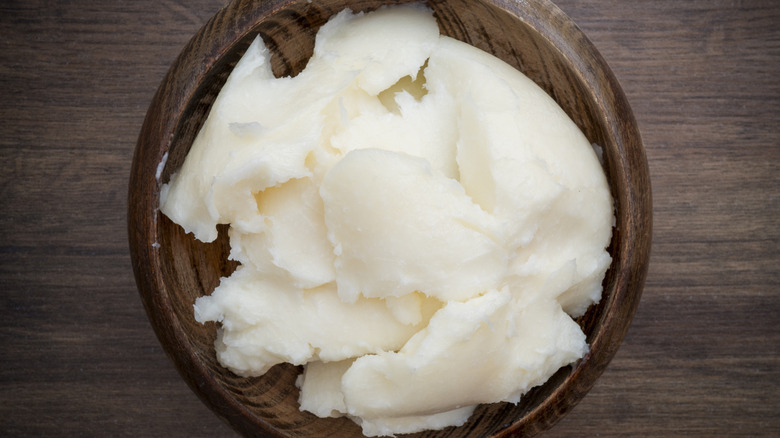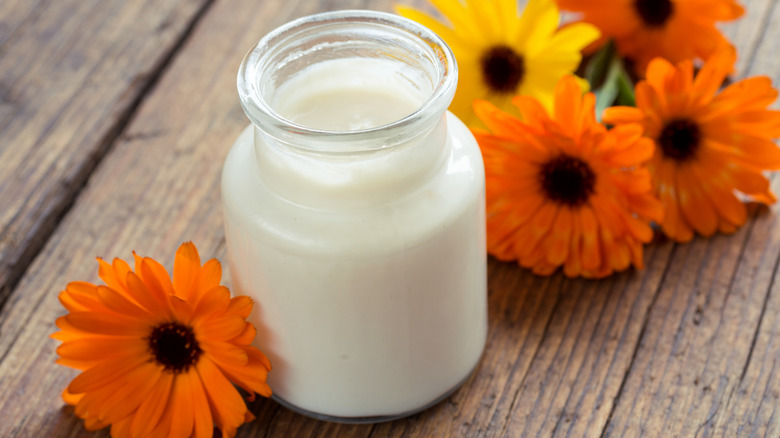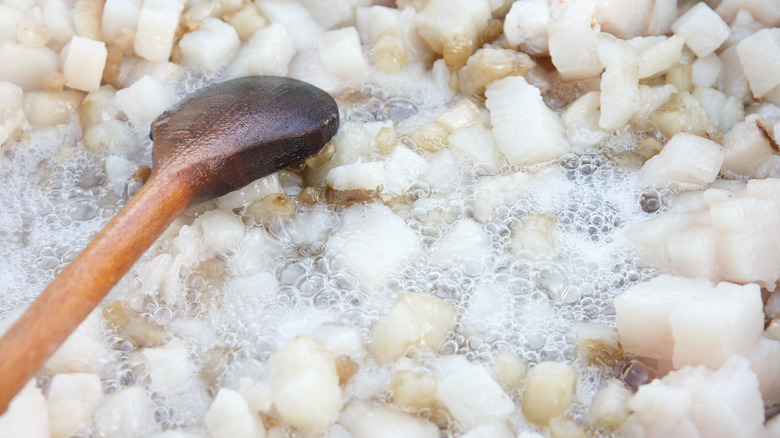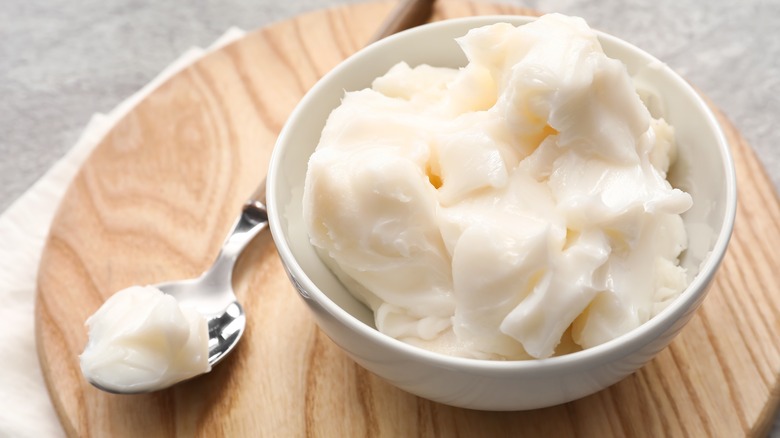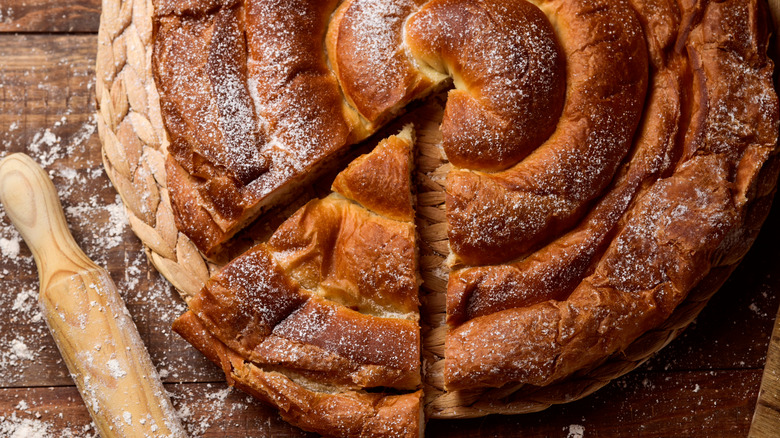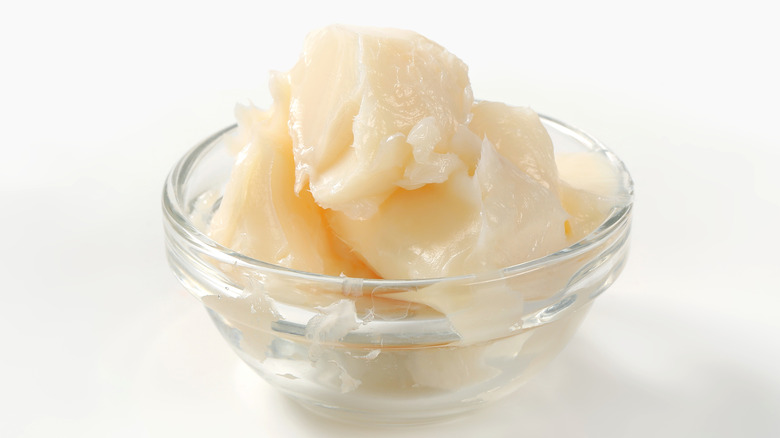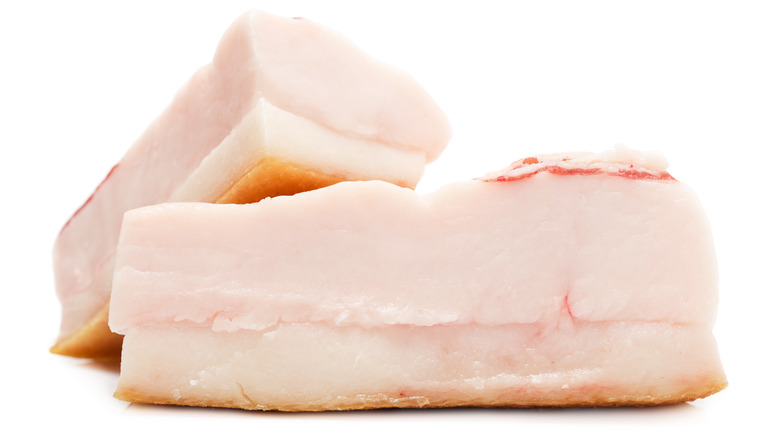The Best Type Of Lard For Baking (& Where You Can Find It)
It's time to rehabilitate the reputation of one of the most misunderstood ingredients in the culinary kingdom: lard. Yes, the rendered pork fat that has launched a thousand crispy, delicious dishes has become more associated with heart disease than good cooking. Unfortunately, this negative distinction causes plenty of home cooks to rule out one of the more versatile and tasty fats they can use.
Cooks aren't the only ones who need to reevaluate lard. Bakers are also missing out on the benefits of lard, specifically what it can do for the texture of their pastries. But for a baking project, not just any only lard will do. Leaf lard, a specific and premium type of lard, has been a baker's best friend for hundreds of years. It's interwoven into the historical baking traditions of European, Asian, and North and South American cuisines, from the British Lardy cake to the Portuguese ensaïmada. So what is leaf lard, how do you use it, and where can you find it?
What is leaf lard?
So what's so special about leaf lard? This lard comes from the premium fat that surrounds the pig's kidneys and loin, a leaf-shaped section of fat that's spreadable at room temperature. What separates this from other types of lard is the level of purity. Most processed lard is made up of miscellaneous fat from all over the pig, a hodgepodge of parts that contain some of the more inferior cuts, which can lead to fat with lingering pork flavor and slightly brown color. Even the back fat lard will have a less refined taste and an off-white color.
Leaf lard doesn't have this problem. Whiter, softer, and purer than any other type of lard, leaf lard has the signature high smoke point and a low melting point of regular pork fat without any of the impurities. This makes it the prime lard choice for bakers.
How is leaf lard made?
If you're the type of home baker who goes to the extremes of "from scratch," you can try your hand at making your own leaf lard. It's a cheaper, if more complicated, option. First, you'll need to go to a butcher or trusted meat source for some quality leaf fat. You'll want to specify that you want only pasture-raised pork fat, not fat from commercially-raised pigs. Why? Fat is where a lot of harmful additives, chemicals, and other nasty tidbits are stored, so you want to be using pork fat from pigs that have had minimal chemical tampering.
Once you have your leaf fat, you'll render it using either a slow cooker or a Dutch oven on the stove-top or in the oven. Small particles of solid pork will need to be strained out at the end of the rendering process — please turn those into crispy cracklings. By the end, you'll have snow-white leaf lard that can be stored in the freezer for up to 6 months.
What does leaf lard taste like?
Truly superior leaf lard should be odorless and flavorless, bringing nothing but a crispy texture to the table. This is exactly what bakers need to create something sweet and crisp with basically no pork flavor. If you want to create something more savory, like a crust for a chicken pot pie or a rich pan of cornbread, regular lard or even bacon grease (fat rendered from frying bacon) will work wonders. But for all other baking projects, the pork flavor should be avoided.
Hence, there is a necessity for leaf lard's flavorless taste. Like vegetable shortening, it provides a truly neutral backdrop for other sweet flavors like chocolate or vanilla. Some recipes may still work best with butter as the primary fat of choice, as its rich milk fat offers a buttery flavor that most bakers wish to impart to their baked goods. But for the most part, leaf lard can be used 1:1 instead of butter or shortening without affecting the flavor.
What and how to bake with leaf lard
Finally, you have your lard, and you've preheated your oven. What next? Focus on recipes that require flaky crusts or a level of lamination, like a double-crusted pie or biscuits. You'll use your lard much like you would butter or shortening, working it into the dry ingredients until only pea-sized clumps of the fat remain. In the oven's high heat, the fat will melt and create layers within the dough, leading to an unparalleled texture.
Another way to discover the flaky benefits of baking with lard is to try a recipe that historically used lard. Ensaïmada de Mallorca is a spiral pastry with plenty of leaf lard worked into the dough to create its signature texture. Technically difficult but incredibly delicious, the classic recipe has used leaf lard since the 17th century. For a more simple recipe to start with, give bizcochitos, the state cookie of New Mexico, a try. With a tender texture similar to shortbread, bizcochitos are an anise-spiced cookie that gets a perfect crumb from lard. Whether you start with a pie crust or with a cookie, you'll quickly discover that leaf lard can be your new secret weapon in the kitchen.
Where to buy leaf lard
As leaf lard is made from a specific kind of fat on the pig, it makes sense that this product would be considered a specialty item. Butcher shops and specialty meat markets will no doubt be able to help supply you with leaf lard, but it probably won't be easy to find in your average grocery store. Luckily, modern shoppers can enjoy the ease of ordering it online as well at places like Amazon or Etsy.
Be prepared to part with a pretty penny, as leaf lard is much pricier than generic lard. While one 14-ounce jar of lard may run for $13.99, a 14-ounce jar of leaf lard will be more than double that, costing almost $30. Keep in mind you're buying quality lard that has been harvested the old-fashioned way, with properly fed, pasture-raised pigs. Knowing you're getting the good stuff may be worth the extra few dollars.
Nutritional information about leaf lard
Health-wise, leaf lard and basic rendered lard aren't nearly as bad as rumored. It represents purified fat, a healthier form of saturated fat that leads to good cholesterol (the kind that regulates hormones and the like). Trans fat, the main culprit for artery-clogging bad cholesterol, doesn't factor in.
In fact, lard's tainted reputation has more to do with a smear campaign run by Crisco and other vegetable shortening brands in the early 1900s than with actual science. All told, lard is better for you because of its limited processing, a more natural alternative than chemically engineered shortening. This isn't to say you should add copious amounts of lard to your daily meals. Like everything else to do with fat and health, moderation is key.
Remember that some lard is highly processed and hydrogenated, making it as dubious as shortening, so read the labels. Again, leaf lard is the purest, least processed lard on the market, so you don't have to worry about having these pratfalls.
Other varieties of lard
Simply put, all lard is made of pork fat. What defines the quality of the lard is how it's processed and rendered and what part of the pig the fat comes from. All lard goes through the process of rendering, where solid pork fat is either heated low and slow on the stovetop or with boiling or steaming water. This helps remove excess water and moisture from the fat, making it shelf stable. Now that it's been rendered, the flavor is cleaner and less porcine. This is known as basic rendered lard.
Processed lard takes things a step further, filtering and hydrogenating the rendered fat so that it's extra shelf-stable, requiring no refrigeration. This kind of lard is made of different fat parts from all over the pig. Most chefs and bakers prefer to use the less processed rendered lard.
This brings us to the final distinguishing characteristic between certain lards: where the fat comes from. For high-quality lard, butchers focus on two specific parts of the pig — the generous strip of fat from the back and the lumpy leaf fat around the kidneys. While the back fat is great for making lard for savory endeavors, leaf lard is the highest grade lard a chef or baker can purchase.
